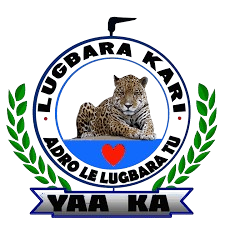CULTURAL INSTITUTION

LUGBARA LANGUAGE
The Lugbara language is the language of the Lugbara ethnic group. It is spoken in northwestern Uganda's West Nile District, as well as the Democratic Republic of the Congo's Orientale Province. Lugbara was first written by Christian missionaries in 1918, based on the Ayivu dialect. In 2000, a conference was held in the City of Arua in northwestern Uganda regarding the creation of a standardised international orthography for Lugbara. In 1992, the government of Uganda designated it as one of five "languages of wider communication" to be used as the medium of instruction in primary education; however, unlike the other four such languages, it was never actually used in schools. Aringa language, also known as Low Lugbara, is closely related, and sometimes considered a dialect of Lugbara. Some scholars classify Lugbara language itself as a dialect of the Ma'di language, though this is not generally accepted.
LUGBARA CHIEFDOM
Lugbara Kari (which can be translated as "House of Lugbara") refers to the official traditional and cultural institution of all Lugbara people on Earth[1] and headed by the Agofe. Although cultural institutions were abolished in 1967, the 1995 Constitution of Uganda helped revive them. Lugbara Kari started rebuilding by establishing interim county chiefs answerable to the Agofe. The 3rd Agofe of Lugbara Kari is educationist Jason Avutia who will be replaced through elections in 2021 after his 94th birthday. Administratively, Lugbara Kari has county chiefs[2] who answer to the elected Paramount Chief; each chief (from Ayivu, Maracha, Terego, Vurra, Aringa, Madi, Kebu, etc) is a potential future agofe. The Lugbara have no opi [Translated from Lugbara: king]. Functions and objectives of Lugbara Kari include enhancing cooperation among Lugbara and promoting heritage plus the Lugbara language. With the motto "MUNGU le Lugbara ambo [GOD loves the Lugbara very much]", Lugbara Kari uses a leopard as an emblem. It's also the identity[3] of the Kari's capital.
The Lugbara have someone called the AGOFE who is charged with the duty of preserving the culture through writing plus other assignments.
Some of the Objectives for forming the Lugbara Cultural Institution include:
1.To forster, enhance and preserve the cooperation, unity, trust and understanding, dedication to work and mutual respect among Lugbara;
2. To promote cultural heritage of Lugbara and Lugbara ti;
3. To preserve, regulate the culture of traditional dances;
4. To encourage collection and preservation of ancient artefacts, social life as well as other traditional things;
5. To encourage research; 6. To promote cultural linkages; 7. To improve agricultural practices;
8. To promote industrial cooperation and land conservation;
9. To award and honour Lugbara who have excelled in various fields;
10. To set up a Fund for promoting culture;
11. To cooperate with government institutions in achieving the above objectives (The Arua District Local Government following its own community-oriented objectives has actually accepted to support the Lugbara initiative).
AJUA - Tara Origins
Some call this place "Tara-dise" because it rocks their world. You may marvel at heavenly views of breathtaking rock formations and mountains namely Liru plus Wati (in Terego) like when Clouds hug their tops or at Sunset - GOD surely painted better than Michaelangelo and Pablo Picasso combined; the plush-green vegetation is refreshing; the well arranged Maize, Cassava, Groundnut, Soya and Tobacco (Assets) Gardens plus simple rural lifestyle seem unmoved by urban chaos. Tara is found on the Northern Border of Maracha, about an hour away from Koboko Town and DR Congo.
A man called Ajua is the great-grandfather of Tara Parishes. Ajua (Abi pi ama tipi Tara'a woro) wanted to see where Ono (River Enyau or Anyau) ends. So he moved with his cows and found people dancing at a dog funeral in Onduparaka (North of Arua Town). He joined in the dance and was given a wife. She gave birth to Opodria who later birthed Naye, the father of the Seven True Parishes of Tara. Ajua left Onduparaka on his quest and went to Ovisoni (West of Arua Town). There he also found people dancing and was allowed to join them. He was given another wife. Some say he paid bride price. The woman gave birth to Otu (Lugbara for 'Umbilical Cord'), the father of Vurra, after whom a County was named in Western Arua District. Otu is the step-brother of Opodria, the grandfather of the other Vur(r)a, a Parish in Tara Sub-County which encompasses the villages from East/West Kololo, Pajuru to Odupiri. Vur(r)a's six brothers after whom Parishes are named in Tara Sub-County (Part of Lower Maracha created from Yivu Sub-County which used to be in the Maracha County of Arua District) include Ojapi (Angusara is the fore-father of Baria Village), Ajulepi, Yidu (Pajama Area), Oliapi (Oliyepi), Aruwe and Rendu. [Oral Tradition Courtesy of Kefa Bayoa Dobo]
When adventurers visit Tara, they write their names on the rocks and take small ones as souvenirs plus for research purposes. For instance, if you stand at the soccer field of Ojapi Primary School, the ranges anticlockwise from Mt. Liru include Kodro, Gala, Kadri, Adrofiya and Njeke (or Njakai). On the South Side of Ojapi as you move from Oliapi Primary School to Orani (which also has a rock named after the place), you will see Adada (which reminds one of big road construction trucks) and Luturujo (which translates to "The House of/ on a Hill). In the evening, after an honest day's work, men sit on the ground or the innumerable rocks, in circles (of four to five), around a calabash of Kwete or bottle of Umkhomboti and drink while chatting about politics and life in general. On market days like at Mabira, Ajira, Gili Gili and Odupiri, women sell foodstuffs as the sun sets. The Grasshopper is the Staple Food and Emblem of Maracha, a Lugbara Clan. Also famous for the Mairunji trade, it is as though Maracha was built on ROCKS. Other Sub-Counties in Maracha include Omugo, Aiivu, Uriama, Nyadri, Yivu (which used to encompass the whole of Tara) and Oleba.
Sources: https://en.wikipedia.org, http://lugbaraculture.blogspot.com
